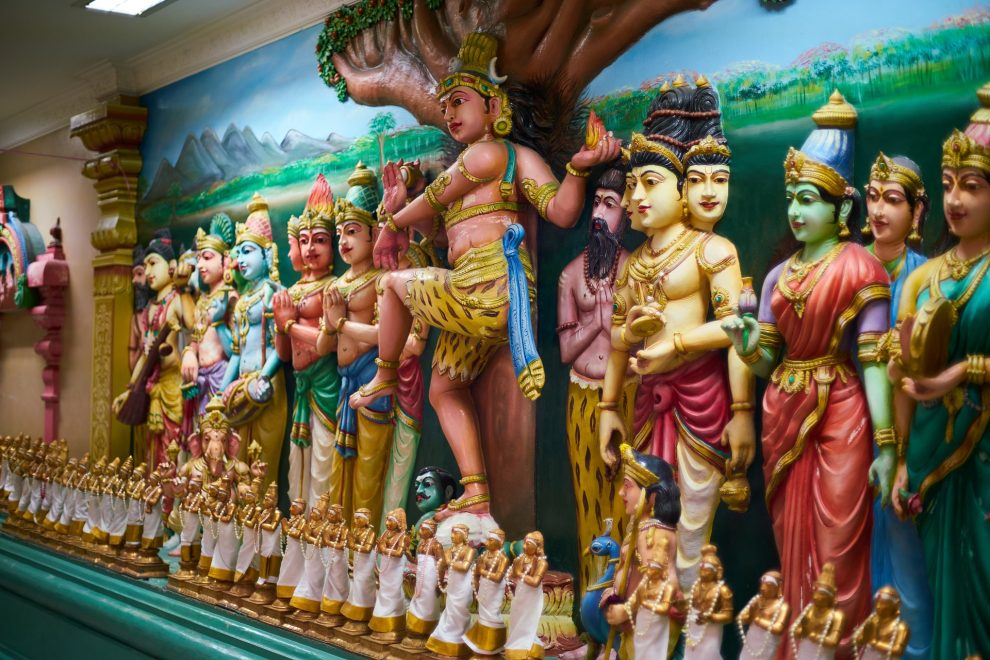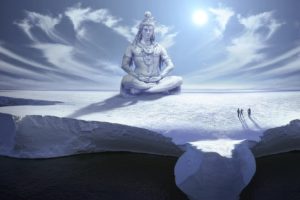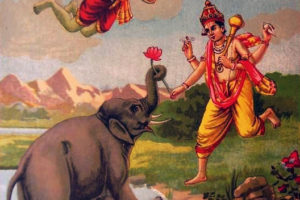Rivalries abound in the world, even among Hindus, who occasionally vie for the supremacy of their Deity: Vishnu or Siva
By Satguru Bodhinatha Veylanswami
Have you ever heard a discussion between two or more Hindus as to who is greater, Vishnu or Siva? As is the case with many philosophical issues in Hinduism, there is, of course, more than one point of view.
Historically, the rivalry of sects has occasionally become violent. In 1760 two great throngs vying for supremacy clashed on the final day of bathing at the Kumbha Mela in the holy city of Haridwar. Violence ensued and Saiva and Vaishnava naga babas turned the festival into a killing ground. In all, 18,000 monks died that day.
In modern times, the rivalries are more verbal than physical, but they are real and not infrequent. In fact, they arise more lately, because Saivas and Vaishnavas are mixing freely. A Hindu family’s friends and neighbors are just as likely to be from another sect–unlike in olden days when sectarian communities were more isolated and homogenous. Plus, these days one can find Vishnu and Siva side by side in the same temple, something unheard of even 50 years ago. Such temple arrangements themselves confuse worshipers, provoking them to wonder, “Who is the greatest among the Gods?”
Our first answer is based on the Vaishnava scripture Srimad Bhagavatam (also called Bhagavata Purana), in which Lord Vishnu/Krishna is the Supreme, all-embracing God of all Gods. The Bhagavatam enjoins devotees of Lord Krishna to not disrespect Lord Siva, but to worship Him as the greatest of the devotees of Lord Krishna. In other words, a Krishna bhakta also prays to Lord Siva, but asks Siva to assist him in attaining devotion to and the favor of Supreme Lord Krishna. The Bhagavatam also contains a story about Siva seated in meditation, eyes closed, chanting on japa beads. It is stated that He is meditating on Lord Vishnu’s transcendental form and chanting Vishnu’s holy names. In the Bhagavatam, Siva is subservient to Lord Vishnu, though He is above the category of an ordinary living being, or jiva. In this position Siva is sometimes referred to as a demigod. In this answer, which represents a Vaishnava point of view, Vishnu is proclaimed to be greater than Siva.
A second answer is found in a story from the Saiva scripture Siva Purana. Brahma and Vishnu were engaged in an argument about who was greater. The dispute grew so intense that the world was threatened. The devas requested Lord Siva to intervene. Siva appeared before them in the form of a fiery column of light, called Jyotirlinga, of which they could perceive neither the beginning nor the end. A contest was devised by the two: the one who first found either end of the Jyotirlinga would prevail as the greater. Vishnu mounted his boar (varaha) and tunneled downward through the nether worlds; Brahma, mounting his swan (hamsa), ascended through the upper worlds. Failing to find the bottom, and totally exhausted, Vishnu returned to the surface. Brahma, failing to find the summit, resorted to a dishonest ruse. Encountering a ketaki flower falling through space, Brahma cajoled it to falsely testify that He had reached the pillar’s summit. Upon returning to the surface, he was boasting of his achievement when suddenly Lord Siva appeared in the middle of the Jyotirlinga and unequivocally declared Himself to be beyond their ken and thus the greatest. Brahma was castigated by Lord Siva for his deceit. Thus Brahma is not worshiped in any temple in India, except in Pushkar, a few miles from Ajmer, in Rajasthan. In this answer, which represents a Saiva point of view, Siva is manifestly greater than Vishnu.
Sometimes the rivalry between the Vaishnavite’s staunch adoration of Lord Vishnu and the Saivite’s steadfast adoration of Lord Siva goes to extremes. This is illustrated in a classic story that took place at the Shankaranarayanar Temple in the Tirunelveli District of Tamil Nadu, where the main murti is one half Siva (Shankara) and the other half Vishnu (Narayana). One day an overly zealous Saivite entered the temple to worship the Lord. Before offering incense, he plugged the nostril of Vishnu with cotton to prevent Him from enjoying the fragrance. Seeing that happen, a bigoted Vaishnavite made his offering, plugging Siva’s nostril so only Vishnu would enjoy the offering. The story demonstrates the foolish nature of fanatical sectarianism.
How is it that one Purana extols Vishnu as the Supreme and another elevates Siva? Swami Sivananda, founder of the Divine Life Society, explained, “Vishnu Purana glorifies Vishnu and in some places gives a lower position to Siva. Siva Purana glorifies Siva and gives a lower status to Vishnu. This is only to instill and intensify devotion for the respective Deity in the hearts of the devotees. In reality, no Deity is superior to another. You must understand the heart of the writer.” Swami’s commentary continues, providing a third answer to our question. “Accordingly, the scriptures hold that Vishnu and Siva are ultimately the same. Smarta theologians have cited many references to support this point. For example, they interpret verses both in the Sri Rudram, the most sacred mantra in Saivism, and the Vishnu Sahasranama, one of the most sacred prayers in Vaishnavism, to show this unity… Sri Sankara also has said in very clear terms that Siva and Vishnu are the one, all-pervading Soul.” In this answer, which represents a Smarta point of view, Vishnu and Siva are equal; and more precisely, they are identical.
This same teaching is found in the Shikshapatri, a Vaishnava text written by Bhagwan Swaminarayan. “The Vedas proclaim Narayan and Shiv as one and as Brahmaswarup–God’s true nature–and, therefore, they should be known accordingly.” Bhagwan Swaminarayan enjoins his devotees: “In the month of Shravan they shall worship or engage the services of pious Brahmin devotees to worship Shiv with Bilva-patras and the like.”
Sometimes the story of the worship of Sankaranarayana by the bigoted Vaishnavite and overly zealous Saivite is marshalled as proof that sectarianism is inherently narrow-minded and all Hindus would be better off being nonsectarian. However, there is another approach to sectarianism, which is the ground for our fourth answer to the question “Who is greater, Vishnu or Siva?” We can call this the tolerant, sectarian approach. The Tamil Lexicon, published by the University of Madras, contains these terse but excellent definitions: “Saivam: The religion which regards Siva as the Supreme Being and is exclusively devoted to His worship, of sixteen sects. Vaishnavam: The religion which holds Vishnu to be the Supreme Being.”
A tolerant sectarian Hindu accepts both of these points and does not conclude that one is true and the other false. They are simply two different names and two different concepts of the Supreme Being. The idea that there can be multiple valid viewpoints about the Supreme is certainly a core Hindu concept. It is captured in the Rig Veda (1.164.46): Ekam Sat viprah bahudha vadanti, “Truth is One, sages describe it variously.”
Renowned philosopher Dr. S. Radhakrishnan, president of India from 1962-1967, offers a definition of Hinduism that stresses the same point. “The Hindu recognizes one Supreme Spirit, though different names are given to it.” The conclusion of this tolerant sectarian viewpoint is the same as the Smarta’s–“Vishnu and Siva are equal.” The basis for this conclusion, though, is different. Here the reason they are equal is that each is the Supreme Being to a different Hindu denomination.
Clearly there is a need for a tolerant, rather than a fanatical or bigoted, sectarianism in today’s Hindu world. One of the reasons is that many temple societies outside of India have shrines or adjacent temples to both Siva and Vishnu, with priests of both traditions working closely together, and devotees of both denominations attending.
We had the privilege of attending the 2004 kumbhabhishekam of the Siva temple at the invitation of the Hindu Temple Society of Greater Atlanta. Siva’s sanctum was built adjacent to a temple for Venkateshwara, Lord Vishnu, which had been constructed years earlier. During our visit, we were greatly impressed that Vaishnava priests were helping in the Saiva ceremonies and vice versa. The smooth working together of these two priesthoods, and of Siva’s and Venkateswara’s devotees, was uplifting and encouraging. It shows how well these traditions can cooperate and blend their energies without giving up their distinct beliefs and customs. I have observed this inter-denominational harmony elsewhere, including the Hindu temple in Memphis, Tennessee, which, in addition to Vaishnava and Saiva priests, also engages priests of the Smarta tradition.
In this area, my guru, Sivaya Subramuniyaswami, gave some helpful advice to his followers, who are, of course, Saivites: “Siva’s devotees, with hearts as big as the sky, love and accept Smarta, Sakta and Vaishnava Hindus as brothers and sisters, even if not accepted by them, and keep harmony by not discussing differences.”
The next time you are involved in a discussion about who is superior, Vishnu or Siva, feel better prepared, as you now have four different points of view to which you can confidently refer. And who knows, you may be inspired to develop a fifth point of view–such is the nature of Hinduism!
For more beautiful articles on Hinduism please visit Hinduism Today















Add Comment